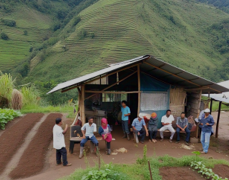“People need to stop financing denial of climate change”
—–Al Gore, Former US Vice President
Climate change issues have become imperative globally because of the growing and dire manifestation of the phenomenon with time.
The global concern for climate change and its implications has been strongly represented in the Sustainable Development Goal (SDGs), precisely SDG 13, which encourages nations to take urgent actions to combat climate change and its impacts.
As the climate crisis progresses, many local people, especially in the more sensitive areas, must adapt to the situation. From farmers coping with changes in rainfall patterns to coastal communities trying to survive constant flooding, adaptation is not a future concept; it is a necessity that has to be addressed now.

However, funding remains a hurdle for many regions. More often than not, traditional funding models with good intentions fail to adequately respond to bottom-up strategies due to funding silos, red tape, or donor priorities.
good news is that many of these issues have evolved with the recent development of technologies that aim to solve the problem. The article looks at seven different finance aids that focus on improving climate change adaptation on a more regional level.
Climate Financing
Climate finance refers to funding and other resources used to take action against climate change through investments in adaptation, mitigation and resilience. It is an essential tool that can come from a range of sources, including national governments, international organizations, private businesses and grassroots fundraising campaigns.
Climate finance is essential in helping the world’s most vulnerable communities cope with the growing impacts of climate change.
By providing resources for adaptation, resilience building and anticipatory action, climate finance enables countries to mitigate climate risks and safeguard livelihoods, particularly in regions facing both conflict and climate shocks.
Many innovative financing for adaptation and resilience can be leveraged to help compensate for the financing gap that keeps widening with time across vulnerable communities of climate change effects. These sources can be invaluable in the mitigation measures adopted. A few are discussed below:
Local Infrastructure Funding Using Green Bonds
Green bonds have traditionally supported large-scale mitigation projects such as renewable energy.
They are now being adapted to fund climate change projects on a more local level, which includes flood and drought-resilient community infrastructure like curtains, sustainable drainage systems, and irrigation systems.
For instance, Mexico City’s green bonds issued in 2017 targeted the funding of water infrastructure and the mitigation of flooding risks for vulnerable sub-divisions in the city (Climate Bonds Initiative, 2022).
This creates opportunities for even municipalities and local cooperatives to access capital that would have otherwise been non-existent through traditional development aid circuits.
Green bonds seem like a great opportunity but have hurdles to overcome. They require significant credit ratings and high levels of transparency which are traits lacking in most small municipalities. Partnerships with multilateral banks and national governments can be great aids in overcoming these challenges.
Platforms for Community Financing and Crowdfunding
With the aid of technology, localized climate adaptation has become accessible via crowdfunding. Communities can now easily reach both local and foreign donors through GoFundMe, Kickstarter, and even M-Changa which is specific to Kenya.
A case in point is the “Adopt a Mangrove” project in the Philippines where crowdfunding aided in restoring mangrove forests which in turn protected coastal areas from storm surges (Leal Filho et al., 2021). These initiatives not only fundraise but also promote participation and awareness at the community level.
The biggest advantage of crowdfunding is that it gives everyone a chance to obtain financing, though they will have to rely on the sometimes fragile digital infrastructure available to them. But without strong narratives, digital access, robust campaign marketing, and storytelling, the campaign may falter.
- Insurance-Linked Instruments and Climate Risk Insurance
Parametric insurance and other insurance-linked securities are rapidly becoming essential tools for climate resilience. Unlike traditional insurance, which compensates for actual losses, parametric insurance pays out when predefined climate triggers, such as rainfall levels or wind speeds, are met.
For example, the African Risk Capacity (ARC) offers weather-indexed insurance to African countries, facilitating swift disbursement of funds to affected areas (African Risk Capacity, 2023). Microinsurance schemes tailored for farmers in countries like India and Kenya also assist smallholders in recovering from climate shocks.
When extended to community organizations or cooperatives, such insurance models can safeguard livelihoods and ensure rapid recovery. Blended finance, which includes public subsidies or philanthropic capital, is often employed to make premiums more affordable.
Payment for Ecosystem Services (PES)
PES is a financial mechanism where landowners or communities are compensated for managing their ecosystems in ways that provide climate-related benefits, such as flood mitigation, carbon sequestration, or water purification.
In Costa Rica, one of the most established PES programmes in the world pays forest owners to maintain forest cover, which in turn contributes to climate regulation and disaster resilience (Pagiola, 2008).
Locally, PES programmes can fund community-based mangrove restoration, watershed management, or agroforestry systems. New digital platforms and satellite monitoring technologies are making it easier to verify ecosystem services, thereby enhancing transparency and trust in PES schemes.
Climate Resilience Impact Investing
Impact investors are increasingly recognizing the importance of climate resilience, particularly as climate risks threaten long-term returns. Climate resilience impact investing focuses on supporting businesses and projects that build adaptive capacity at the local level—ranging from climate-smart agriculture to early warning systems.
Funds like the Acumen Resilient Agriculture Fund (ARAF) invest in African agricultural enterprises that help smallholders adapt to climate change (Acumen, 2021). These investments often combine commercial capital with concessional finance to de-risk ventures and amplify social impact.
By investing in local entrepreneurs, impact investing creates jobs, builds capacity, and encourages innovation—all while addressing climate vulnerabilities.
Diaspora Financing and Climate Remittances
Remittances from diaspora communities are a vital source of income for many developing countries. Increasingly, these funds are being channelled toward climate resilience. Diaspora bonds and climate-linked remittance schemes can support infrastructure, housing, and water security initiatives.
For example, Ethiopia and Nigeria have successfully issued diaspora bonds for national development, a model that could be replicated for climate adaptation projects (Ketkar & Ratha, 2010). In Bangladesh, NGOs have facilitated diaspora contributions to cyclone shelter construction.
Diaspora financing taps into a strong emotional and social connection with home communities, which can drive sustained commitment to climate resilience goals.
Blockchain and Decentralized Finance (DeFi)
Blockchain technology is unlocking new ways of financing climate adaptation, particularly by improving transparency and reducing transaction costs. Smart contracts on blockchain platforms can automate funding disbursements when certain adaptation milestones are met.
Startups like GainForest use blockchain and AI to verify and reward local communities for environmental stewardship, such as reforestation and flood protection (GainForest, 2023). Blockchain is also being explored for PES schemes, climate insurance, and community savings groups.
While still nascent, blockchain holds promise in creating decentralized, trustless systems that can directly link funders with community projects—bypassing traditional intermediaries.

Conclusion
The gap in climate adaptation financing is still too high, estimated to exceed $300 billion annually by 2030 (UNEP, 2023). Nonetheless, the development of innovative financing approaches presents a powerful chance to support local communities that are disproportionately affected and take the most initiative in responding to climate challenges.
Such financing includes green bonds, crowdfunding, and even blockchain and has the potential to democratize climate action, increase local stewardship, and foster enduring resilience.
For everyone—from policymakers to investors and practitioners—the solution is to incorporate these methods into wider adaptation strategies: scaling effective interventions, leveraging bottom-up insights, and prioritizing the voices of those most affected.
References
Acumen. (2021). Acumen Resilient Agriculture Fund. https://acumen.org/arf
African Risk Capacity. (2023). About ARC. https://www.africanriskcapacity.org
Climate Bonds Initiative. (2022). Mexico City Green Bonds Case Study. https://www.climatebonds.net
GainForest. (2023). Smart Contracts for Climate. https://www.gainforest.io
Ketkar, S. L., & Ratha, D. (2010). Diaspora bonds: Tapping the diaspora during difficult times. Journal of International Commerce, Economics and Policy, 1(02), 251–263.
Leal Filho, W., Nagy, G. J., Borthwick, F., & De Campos, I. C. (2021). Crowdfunding as a solution to finance adaptation projects in vulnerable communities. Sustainability, 13(4), 2161. https://doi.org/10.3390/su13042161
Pagiola, S. (2008). Payments for environmental services in Costa Rica. Ecological Economics, 65(4), 712–724.
United Nations Environment Programme (UNEP). (2023). Adaptation Gap Report 2023. https://www.unep.org/resources/adaptation-gap-report-2023
He is a PhD, Media & Communication student with research interests in Development Communication, Sustainability, Climate Communication, and the Green Economy.
Connect with him via: [email protected] / [email protected]
LinkedIn: Ebenezer Asumang. [ https://www.linkedin.com/in/ebenezer-asumang/ ]










